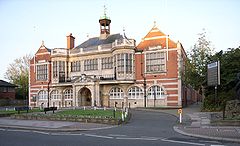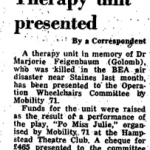Marjorie Golomb Feigenbaum, 1922 - 1972
December 31, 2008
 Majorie Golomb Feigenbaum 1922 -
1972 was a homeopath at the Royal London Homeopathic
Hospital
who who died in the Staines plane crash in
1972.
Majorie Golomb Feigenbaum 1922 -
1972 was a homeopath at the Royal London Homeopathic
Hospital
who who died in the Staines plane crash in
1972.
Homeopaths and homeopathic supporters Dudley Wooton Everitt, Isabel Campbell, (Sisters) Kawther Theresa Kandalla and Ludi Marylone Kandalla, Sergei William Kadleigh, Mary Stevenson, Joan Mackover, John Robertson Raeside, Elizabeth Somerville Stewart and Thomas Fergus Stewart, and Elizabeth Sharp Hawthorn 1918-1972 also died in that fatal crash.
 Marjorie
Golomb was a colleague of Erich Kurt
Ledermann.
Marjorie
Golomb was a colleague of Erich Kurt
Ledermann.
Marjorie Golomb practiced at 9 Danescroft Avenue, Hendon, London NW4.
There were no survivors when the plane crashed, less than four minutes after taking off for Brussels. Its wheels had been retracted and the plane was climbing when it suddenly dropped, skimming over high-tension power lines and across the tops of cars before crashing on its underside.
The impact broke the plane’s spine, ripping off the tail section and sending it spinning through the air. The fuselage slewed across the muddy field and hit a line of trees on the edge of a reservoir.
The plane had hit an incredibly small space - a field no more than 100 yards wide. The way in which it crashed suggested that it might have lost virtually all power; it came almost straight down, missing houses on either side of the field.
A stall, from which the pilot would need a lot of height to recover even if it were not of the dangerous “deep” variety, would have the same effect….
Thirty four Britons were killed in the crash, including the crew. There were 29 passengers from the United States, 29 Belgians, 12 Irish, four South African, three Canadian, one Thai, two Jamaicans, one Latin American, one Indian, one French Afrique, and one Nigerian. There were between 25 and 30 women passengers, as well as two or three children.
The Department of Trade and Industry said the pilot’s last message to ground control came two minutes after take-off. It said “Up to 60? which the DTI said, “Is quite a normal message.” It means the pilot was climbing to a level of 6,000 feet.”
After the crash, wreckage was scattered for a radius if almost four hundred yards around the shattered fuselage. The hundreds of workers struggling in clinging mud and a steady drizzle to cut their way into the buckled remains of the plane were hampered through the night by hundreds of sight-seers flocking towards the area.
Mr. Cranley Onslow, Parliamentary Under Secretary for Aerospace, who went to the scene, said “callous” sight-seers were hampering the rescue workers. Two hours after the crash, all roads in the area were jammed by traffic.
The Trident, on flight BE 548 and code named G-ARPI, left Heathrow at 5.02pm with 109 passengers and nine crew members. By 5.06pm, it had crashed.
A man who had been driving along the A30 told police: “The plane just came whizzing in, along the road. You could have reached up and touched it.”
Heathrow aircraft control sounded the full scale disaster alert, and all airport emergency appliances, together with all available fire engines, ambulances, and police patrol cars for eight miles around sped to the scene. Nine hospitals in the area prepared to receive casualties, and doctors were brought in for emergency duty. In the event, they were not needed.
As the first teams of firemen reached the wreck site - throughout the night they were to work at considerable personal risk as the aircraft contained tones of highly flammable fuel - they clawed with their hands in desperate attempts to reach the passengers inside. A local doctor who ran to the spot said: “It was ghastly, sickening. A terrible mess.”
As police blocked off surrounding roads, other rescue teams began knocking down fences to enable ambulances to reach the plane. By 7pm, 70 bodies had been lifted from the fuselage and laid in long rows along the ground.
Long lines of rescuers formed in the steady drizzle, passing the broken bodies of the victims gently from the shattered fuselage to the ambulances. A number of the rescuers, police and firemen, were crying. One policeman said a small girl died in his arms as he carried her towards an ambulance.
One man was taken out of the wreckage with head injuries but died in hospital. He is understood to be Mr Melville Miller, managing director of Rowntree Mackintosh (Ireland) Limited.
A mobile crane was brought into the field to lift parts of the wreckage away; the rescuers could not use oxyacetylene cutters because of the risk of an explosion. Relays of ambulances began taking the bodies to the special mortuary.
Mr Michael Stephens, of Staines, said he was cycling along a road near by “When I looked up and saw the tail of a plane bounce into the air … then the rest of the plane burst into flames.” The fire was an isolated electrical fault and was quickly put out.
Miss Christine Wallis said she was walking past the reservoir with friends when “bits of metal began flying around us … the plane split up as it tore along the ground.”
Last night teams of investigators from the Department of Trade and Industry and the British Airline Pilots’ Association arrived at the scene to find out the contents of the flight recorders.
The same plane was involved in a collision in July 1968, at Heathrow. It was stationary at one of the terminal piers when a freighter jet carrying horses got out of control and crashed into its side. Five people were killed in the freighter. The Trident’s tail was torn off.
Two seconds after the droops were retracted, the stick pusher stall recovery device operated, causing the autopilot to automatically disengage and the nose of the aircraft to pitch down. At that moment, the stall recovery system was manually inhibited by one of the pilots.
The aircraft then pitched up rapidly, losing speed and height, entering a true aerodynamic stall and then a deep stall from which no recovery was possible. Impact occurred 20 seconds later. An autopsy on the captain suggested that he had probably had a heart attack during the short flight.
Obituary of Marjorie Golomb MB, BS, M F Hom, British Medical Journal 15.7.1972 page 181
Dr. Marjorie Golomb, clinical assistant to the Royal London Homeopathic Hospital, died in the Trident air disaster at Heathrow on 18.6.1972. She was 49.
Marjorie Golomb was born on 4.11.1922 at Hove. Graduating at the Royal Free Hospital in 1946, she worked in general practice at Wembley until her marriage, after which she was for many years a school medical officer in the London Area. As her children grew older and she felt able to give more time to professional work she held posts in psychiatry, dermatology and homeopathy and took the diploma of membership of the faculty of Homeopathy in 1962. She finally chose to make her career in dermatology and held dermatological posts at several hospitals in and around London, including the Royal London Homeopathic Hospital, to which she was appointed in 1962, and St. John’s Hospital for Diseases of the Skin, to which she was appointed in 1971. Three years ago she became a Justice of the Peace for the Borough of Hampstead.
Marjorie’s personal qualities were outstanding and made her a most remarkable doctor. A person completely unselfish in all aspects of her life and professionally modest, she never sought the limelight. The warmth and generosity with which she gave of herself knew no limit, and her devotion to her family as wife, mother and daughter was truly remarkable. A woman of high and sensitive intelligence with a ready wit, courageous and kind, her calm presence always raised everybody’s spirits. To her friends, colleagues and family her loss is indeed a heavy one. Her husband died a year ago and she is survived by three daughters. VC.